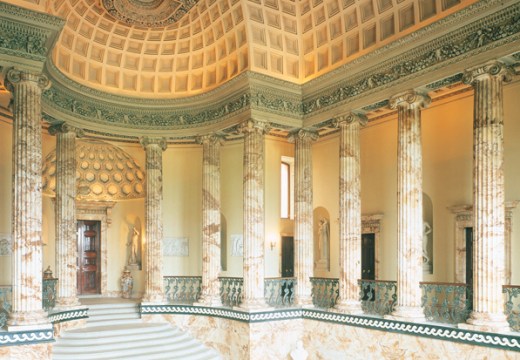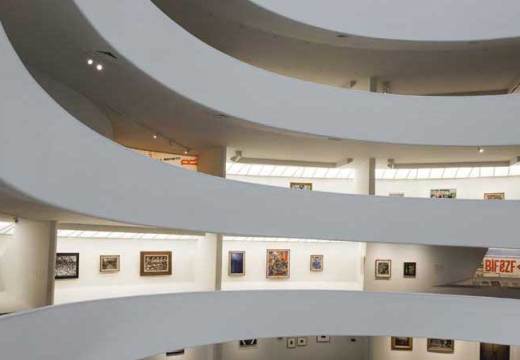On 8 March, ‘Nilima Sheikh: Each Night Put Kashmir in Your Dreams’ opened at the Art Institute of Chicago. This is the first solo museum exhibition of the revered Indian artist, Nilima Sheikh (b. 1945). The small but significant show features eight large banners (305 x 183cm), painted between 2003 and 2010, and two that were created especially for this installation.
Collectively, they capture the complex nature of the Kashmir region. Renowned for its beauty – often referred to as a paradise on earth – it is also infamous for its turbulent history. Since the partition of India and Pakistan in 1947, the area has been disputed, resulting in civil unrest, the formation of violent insurgent groups, and deaths.
The title of the series and the exhibition is a line from the poem, I See Kashmir from New Delhi at Midnight by Agha Shahid Ali. Sheikh’s paintings are greatly influenced by Ali’s poignant prose, in addition to a wide variety of other sources – Indian and Persian miniature painting, Central Asian wall painting, Kashmiri folk tales, the artist’s childhood memories, and the works of medieval, pre-modern, and contemporary authors. The result is a bewildering, vibrant, kaleidoscopic set of works that not only acknowledge the Hindu-Muslim conflict, but cast light on Kashmir’s composite history and culture.
The latter is brilliantly represented through blocks of colour and a collage-like aesthetic that resembles patchwork fabric. In fact, the bottom edges of several works have been intentionally finished like typical Kashmiri shawls. To augment the idea of cloth, each banner is dotted with different types of stencil design, another traditional art form.
I found two personal favourites. Hunarmand features little vignettes that honour the work and skill of Kashmiri craftsmen (hunarmand means ‘one who has a gift or talent’) through the depiction of their tools or of them in the process of creating. On the reverse, Sheikh has created a breathtaking rendition of a map of Srinagar, the capital of Kashmir. The birds-eye view is meticulously detailed, filled with people, temples, buildings, and boats floating along the winding rivers. The map alludes to the famous Kashmiri Map Shawls, commissioned in 1870 by Kashmiri king Ranbir Singh for the Prince of Wales (later Edward VII). However, the prince never made it to Kashmir during his travels to India. Only three of these types of shawls are known to exist.
Son et Lumiere is a brilliant example of the variety of visual sources that inspire Sheikh’s paintings. The seated figure in the centre resembles a Mughal Emperor, symbolising the Mughals’ affiliation to the valley (emperors Jahangir and Shah Jahan built gardens there). The sword-wielding, fantastical figure to the right is the Angel of Death and alludes to the story of Shaddad ibn ‘Ad from Arabian Nights. Shaddad was a mythical Arabian king who tried to recreate Iram or ‘paradise on earth’ and was thus killed by the Angel of Death. It is a thought-provoking inclusion as the exhibition is itself a visual reminder that Kashmir is considered a natural paradise on earth.
Above the Mughal Emperor are three beheaded holy figures that are no doubt derived from Fra Angelico’s Beheading of St. Cosmas and St. Damian. As an art historian who specialises in South Asian and Islamic art, it was easy enough for me to understand these small visual references. But the series’ overall significance was lost on me, and clearly on the other visitors, as there was no explanatory information accompanying the paintings.
Because these pieces are so detailed, so precise and intentional in their manner, I found it frustrating to not have some kind of textual support to fully understand the magnitude of Sheikh’s work. In the exhibition’s slight defence, the banners are suspended in the middle of the two rooms, thus making wall text a bit difficult. Their solution is to provide a small booklet that visitors can pick up and keep at the beginning of the show, which provides, for each painting, a few very general descriptions. The only wall text was the brief introduction, and that was a bit vague and erroneous, failing to provide an understandable backdrop to the recent unrest in the region.
It should be mentioned, with the exception of Hunarmand, that behind each painting, Sheikh has stencilled excerpts from narratives and poetry that helped shape the corresponding paintings. But taken out of context, like the visual references, they only left me wanting to learn more.
Despite this lack of explanation, anyone can appreciate Sheikh’s incredible paintings on some level. She represents Kashmir as naturally and culturally beautiful, but haunted by pain and turbulence.
‘Nilima Sheikh: Each Night Put Kashmir in Your Dreams’ is at the Art Institute of Chicago until 18 May.
Unlimited access from just $16 every 3 months
Subscribe to get unlimited and exclusive access to the top art stories, interviews and exhibition reviews.


















![Masterpiece [Re]discovery 2022. Photo: Ben Fisher Photography, courtesy of Masterpiece London](http://www.apollo-magazine.com/wp-content/uploads/2022/07/MPL2022_4263.jpg)
It’s time for the government of London to return to its rightful home